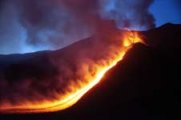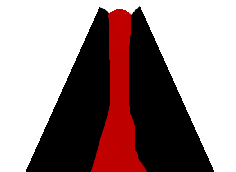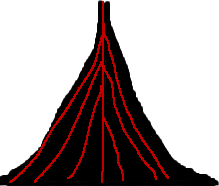
| Drawing representation of a Lava Shield |

Volcanoes are one of the planet's major sources of rocks and minerals. Here we describe the kinds of volcanoes which bring molten rock to the surface. The following pages will describe the types of rocks which these volcanoes produce. Volcanoes differ from other landforms because they are built up from liquid lava ejected to the surface and then solidified. Also, unlike land built up imperceptibly by continental drift, the changes produced by volcanoes can be sudden and dramatic. The form which a volcano takes largely depends on the type of lava and the composition of the rock it is being forced through. The best known forms of volcano are described below.
Lava Volcanoes:

| Drawing representation of a Lava Shield |
Pyroclastic Volcanoes -
Scoria cones are among the smallest of volcanes, generally less than 300 meters in hight. They occur as discrete volcanoes on a basaltic lava field or as nested volcanoes (see below). Many scoria cones erupt only once, unlike Shields or Stratovolcanoes.
Basalt exiting from lava tubes can also generate littoral cones from episodic explosions due to disruption of the lava stream by incoming waves or swells.

| Drawing representation of a Scoria Cone. | |
Composite Volcanoes:
There are many examples of stratovolcanoes including: Mt. St. Helens, Mt. Fuji in Japan, Mt. Mayon in the Philippines, and Vesuvius, the volcano which destroyed Pompeii. Stratovolcanoes are also particularily abundant along the rim of the Pacific Ocean, a region known as the Ring of Fire. Most active stratovolcanoes worldwide appear to be 100,000 years old, although some, like Mt. Rainier, may be more than 1 million years old.

| Drawing representation of a Stratovolcano. | |
| _______________________________ | ||||
| Home | | | Shopping | | | Database |
© Biscuit Software 2004-2015
All rights reserved